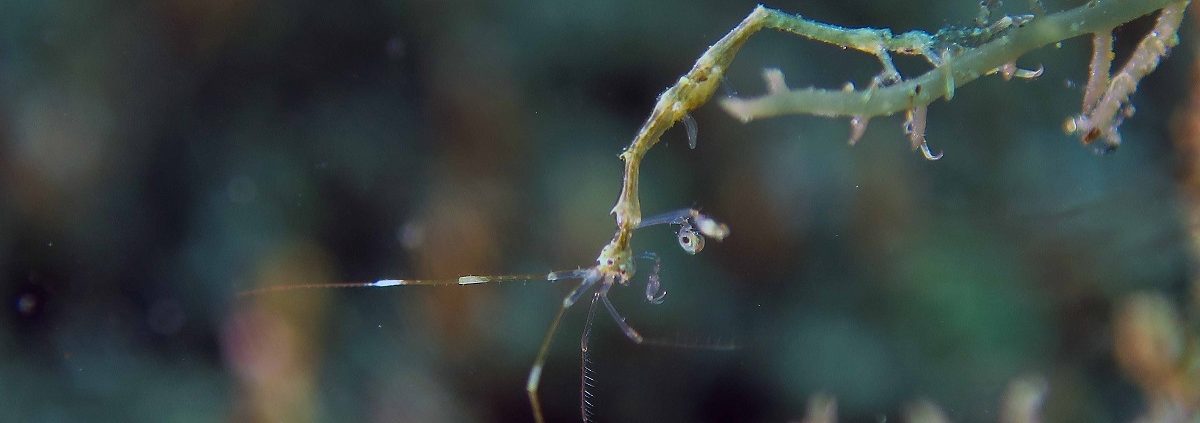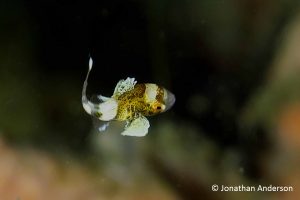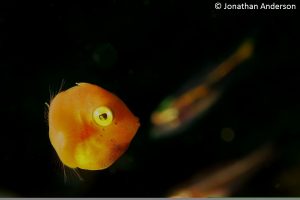18. Small is Beautiful
They say the best things come in small packages, and this is just as true below the waves here in Dauin. A basic magnifying glass is sometimes all you need to enter a brand new underwater world. Here’s a collection of tiny Dauin Critters.
Saddleback Anemonefish (Amphiprion polymnus)
The Saddleback (or Panda) Anemonefish lays a carpet of eggs under the protection of the stinging tentacles of their Anemone homes, and guards them aggressively against all intruders. Zoom in on the picture on the left and you will clearly see the eyes of the unhatched young and their developing bodies in the eggs, less than a 1mm across. Like all Anemonefish, the Saddlepack is a sequential hermaphrodite, meaning they can change sex during their lifetimes. Anemonefish are born male, and a dominant fish transforms from male to female to begin, or take charge of the community, with a hierarchy of males beneath her who pander to their every whim. We all know someone like that.
Harlequin Sweetlips (Plectorhinchus chaetodonoides)
The Harlequin Sweetlips is a favourite reef fish, because of its amazing clown-like patterning, but also for its hypnotic swimming style when young. There are few divers who have managed to pass by this little dancing Critter without stopping to admire its moves, which are said to mimic, for protection, the swimming style of the poisonous flatworms that occasionally take flight around here (see 12. Not all worms are wiggly). Notoriously difficult to take a picture of, this is especially the case when we found this little guy only approximately 5mm long shaking his booty. When they become all grown-up, they don’t need to dance anymore, which we think is just sad.
Kuiter’s Dragonet (Dactylopus kuiteri)
Dragonets distinguish themselves by having exceptionally long dorsal fins which are very mobile, brightly coloured and are frequently waved about like a banner. It is thought that this showy display, along with the flashy markings and painted lips, are used in courtship displays mainly by males to compete for a mate. This juvenile was just over 10mm long, but he was doing his best to make himself noticed by frantically waving his dorsal about and hopping around the place. Biologists have attributed the lower adult survival rates in males compared with females in part to this attention-seeking behaviour, because if we can see them, even this small, then they are guaranteed the unwelcome advances of a passing predator. He who dares, wins (or gets eaten, or both).
Japanese Inflator Filefish (Brachaluteres ulvarum)
At less than 10mm across, this tiny fish that we originally thought was a floating bobble of seaweed, spun on its axis and swam about like a tiddly yellow drone. Filefish are so named for their flattened profile, and leathery skin, which some say when dried was used to sand and smooth wooden boats in tropical climes. They are related to Pufferfish, with whom they share the ability to inflate themselves with water to make them difficult for predators to swallow. Even fully inflated though, this guy won’t be more than a quick snack for anything but the tiniest of predators.
Feather Star Crab (Harrovia Albolineata)
As their name suggests, Feather Star Crabs live singly in one or two species of frondy, plant-like animals called Feather Stars, or more accurately, Crinoids. It was thought for some time that their relationship with their hosts was parasitic, in that they fed on them, but recent studies in Singapore (Raffles Bulletin of Zoology 1990 38(2) pp 257-262…..we do our research!) suggest that they merely steal a planktonic or algae meal from the Crinoid every now and again in return for robustly defending their home. It’s rare to find more than one crab per Crinoid, but most Crinoids will have one of these guys somewhere. However, being less than 10mm across, and matching their surroundings, the discovery of one is a highlight of any dive.










Leave a Reply
Want to join the discussion?Feel free to contribute!